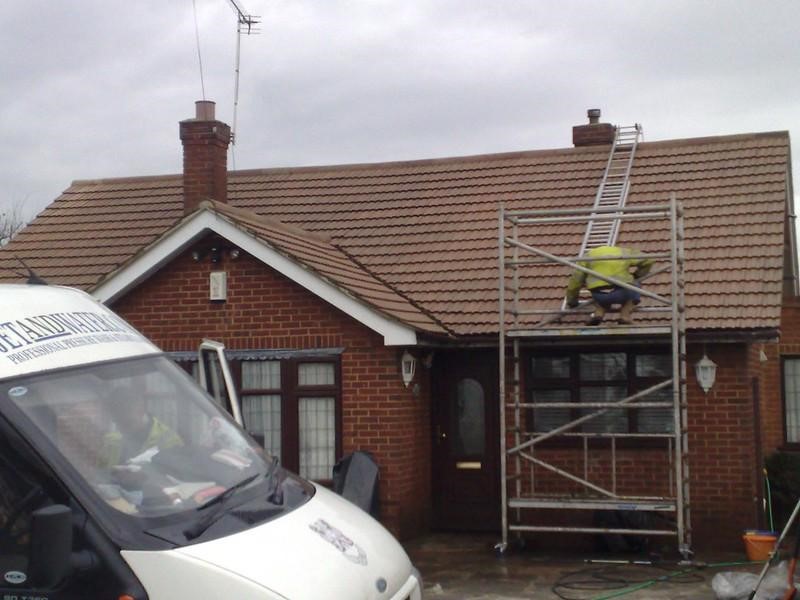
Greenery roofs must be restricted to a flush of new leaves from tree canopies. If mossy foliage or algae is covering your roof, maybe it’s time to clean it. Mosses grow in places spared from sunlight, and algae spread because of the accumulated mildew, mold, or defective shingles.
Moss develops quickly on north-facing, and tree-shaded roofs while algae develop in humid areas. The spread of moss and algae can rapidly press down roof surfaces, causing the heaving of shingles.
If your roof suffers from this roof-destructive greenery, know that there are things that you can do to eradicate them from your roof. Below are some possible solutions.
Roof cleaning is hazardous work, so you need to consider hiring an expert or getting the services of roof cleaning by Crystal Services Group. A roof covered with algae or moss that’s wet is as slippery as black ice.
You may skid accidentally and fall down to the ground. Also, not a lot of people are confident about getting up on a roof. If you are one of them, then it’s wise to hire a pro instead of doing it yourself.
However, for those who want to clean their roofs by themselves, make sure to work on the roof’s dry areas and reach sideways to clean and scrub the wet parts with a cleaning solution. Ensure to wear shoes that have great traction. Also, working and sitting on the roof reduces your likelihood of falling.
An affordable way to remove moss and algae buildup on your roof is to use a 50/50 bleach and water mixture. The equal parts of both elements are enough for loosening and eradicating moss and algae that have developed on the shingles.
Use a pump sprayer to clean the roof with the mixture. Start at the top of the roof and all the way down the gutters. As the solution runs down the gutters, it will cover and loosen the moss and algae buildup on your roof.
After coating the roof with the mixture, wash it with water using a garden hose. As you spray, the algae and mold will eventually loosen off the roof. Continue to spray water until the shingles are all clean.
However, take note that before you start cleaning your roof, spray down with water any foundation plants. Keep in mind that bleach can be harmful to some plants, and spraying them with water before cleaning the roof will protect them. After cleaning, spray any foundation plants with water again.

Aside from the water and bleach mixture, you can also use commercial cleaners to remove algae and moss on your roof. Most cleaners are sold at hardware stores and contain ingredients such as water, trisodium phosphate, and oxygen bleach.
Commercial cleaners pose less risk to your foundation plants and lawn compared to the bleach/water mixture. Even so, before you start cleaning your roof, spray down water on the grass and plants under the roof.
What’s more, use these commercial cleaners on an overcast day. Otherwise, the sun will dissolve the cleaner before it can get rid of the moss and algae.
To stop moss and algae from coming back, you need to take some necessary preventative measures. It can be as simple as installing copper or zinc flashing on your roof. Moreover, to install these flashings, you need to buy at least four-inch strips of zinc or copper from your local hardware store.
Install them beneath the row of shingles near the roof’s peak. Leave at least two inches of the metal unprotected from the elements. But when it rains, the metals’ molecules will kill moss and algae and wash them down before they can even root in your roof.
Installing these flashings doesn’t take a lot of time, effort, and is not difficult. You can use screws or roofing nails with rubber washers to put the metal in place. Another thing, keep in mind that the metal itself can be susceptible to moss and algae buildup.
Keep it free from these elements by cleaning the metal with either a 50/50 mix of water and bleach or commercial cleaner to eradicate the debris. Also, make sure to trim branches of trees overhanging on your roof, regularly get rid of moisture collectors, and keep gutters free of seed pods to keep your roof moss and algae free.
Moss and algae can develop on your roof, probably because it could provide an excellent environment for it. Conditions like humidity, moisture, and shade are the perfect conditions for moss and algae to develop. The ways outlined above can guide you on removing moss and algae buildup on your roof.